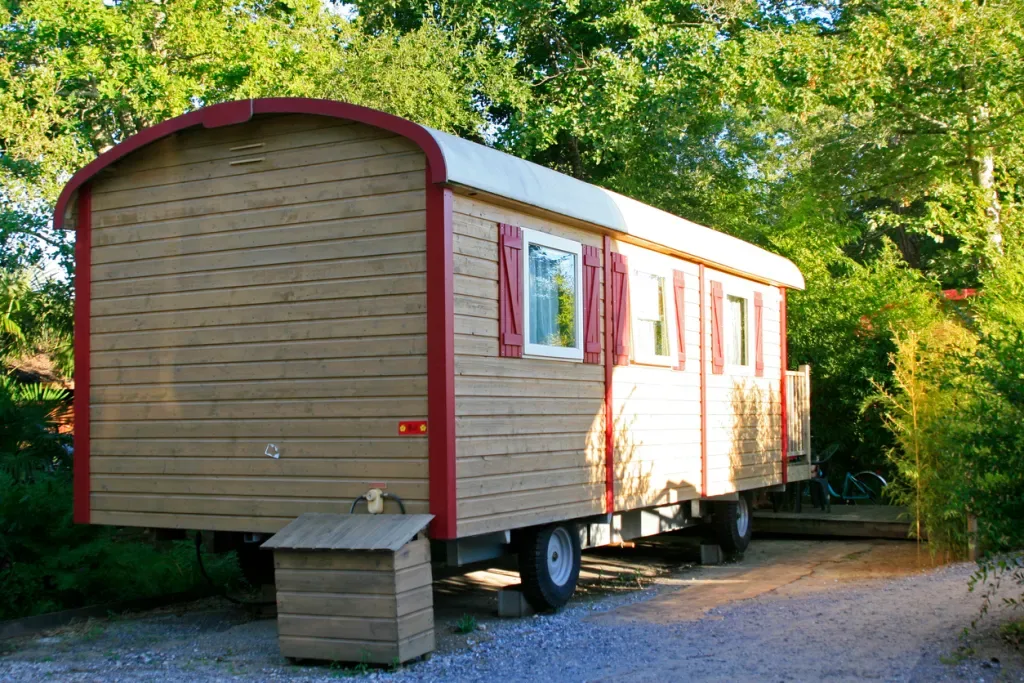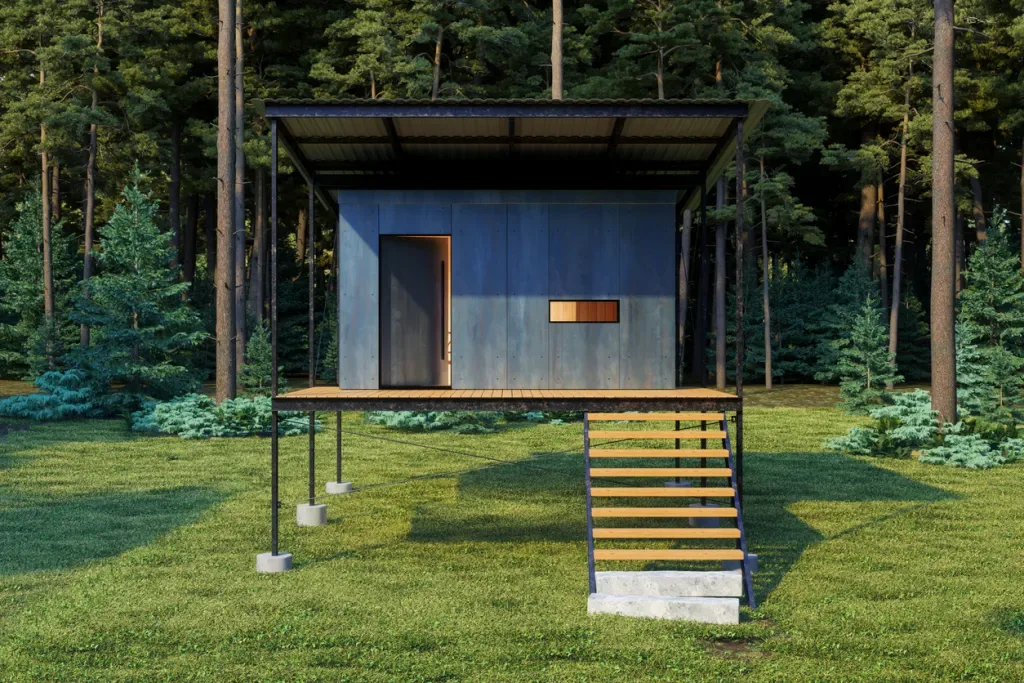Doesn’t an RV tiny home sound like a dream? For a retired man named Kenny, it’s a reality.
When Kenny found a 1976 Dodge RV, he knew it was the perfect vehicle for his miro-home. His unique creation combines the aesthetics of a house with the versatility of a motorhome.
With time and patience, you can pull off your own conversion. However, you should know it’s a more complicated process than it seems.
Let’s jump in!

Innovative DIYer Creates Tiny Home From an Old RV
It’s not every day you see an RV tiny home pull up to a festival. But that’s what Brian, a vlogger with the Cheap RV Living YouTube channel, saw while working at C.H.A.S.M. Fest in Arizona.
Kenny, the owner, has a house in Kansas. When he retired, though, he decided to build his own travel trailer. It began as a boxy structure that he pulled on a flatbed trailer. Kenny later found a 1976 Dodge motorhome and modified it to pull his custom-made living quarters. He finished the project in 2019.
His space features tons of upcycled and found materials. He built a sleeping loft above the driver’s cab, which he can close off using wood panels for privacy and extra seating. We love how he retrofitted his grandmother’s kitchen table with a swivel and attached it to an interior wall for easy storage. He even created a kitchenette using an antique writing desk.
The DIYer also got creative with appliances, including a handmade composting toilet and a custom battery monitor. In addition, he upgraded the air conditioning system, added solar panels, and even created a folding porch! This custom RV tiny home is truly amazing.
What Is a Tiny Home?
You can find as many types of tiny homes as RVs. Some, like Kenny’s, are mobile. Others are built on permanent lots, just like traditional houses. But generally speaking, they’re spaces with fewer than 500 square feet of living space.
Like Kenny, most folks get creative with smaller spaces.
Reduced square footage calls for smaller appliances and furniture pieces. That’s why we see tiny living fans modify their areas to maximize freedom of movement and extra storage.
This type of home gained popularity in the U.S. after the 2008 recession. These small living spaces provided an affordable alternative to traditional houses. With some DIY skills and creative use of materials, you can build one for as little as $15,000.
Shipping containers are also popular bases for tiny homes, but are they worth it? The Unfortunate Truth of Shipping Container Homes.
Should You Use an RV Frame to Build a Tiny Home?
Kenny’s tiny home proves an RV frame can be a great foundation. But this kind of conversion isn’t an easy project. You’ll need to consider several factors before you start shopping for a vintage camper.
The frame you use should meet some basic requirements. You want one that’s sturdy, rigid, and capable of carrying weight at its edges rather than its center. Your frame should also have an axle rating that matches the total weight of the house.
You’ll also need to choose your building materials carefully. Conventional materials might be too heavy and unwieldy for a repurposed motorhome frame. If you fail to meet these requirements, you risk rolling your new residence or crashing it.
Building a tiny home on an RV frame is a big undertaking. If you decide to go this route, carefully inspect the vehicle before purchase and use caution while building your conversion.
How Did the Tiny Home Movement Start?
Tiny homes became uber-popular in the early 2000s. But these small living spaces have existed in the U.S. for decades.
A builder named Jay Shafer created his own tiny house on wheels in 1997. Eventually, Shafer decided to share his knowledge with the world. He founded the Tumbleweed Tiny House Company, which gave people access to blueprints, helpful hints, and building advice. Shafer’s company helped inspire a new generation.
This movement has a lot in common with the RVer movement. It allows you to live an uncluttered life, whether on or off the grid. It’s also easier to enjoy freedom of movement when you aren’t tied to a conventional home and mortgage. As an added bonus, smaller living tends to be eco-friendly, making them the perfect option if you’re environmentally conscious.
Some people prefer overlanding: Frugal Camper Converts Ford F550 into DIY Overland Vehicle.
Is It Hard to Find a Place for a Tiny Home?
These small spaces are affordable, environmentally friendly, and full of DIY possibilities. However, making a tiny house your permanent residence can be tricky. You can’t pull one over just anywhere. Mobile versions are subject to parking rules and regulations, just like campers.
If you don’t plan to put your tiny house on an RV frame, you could still face challenges. Compared to traditional spaces, these dwellings are still something of a novelty.
Many cities have building codes and rules that make building a tiny permanent home in an established neighborhood difficult. You could run into issues with square footage requirements, permits, and even access to basic infrastructure.
Before choosing this lifestyle, do your research. Check your city’s local building codes and regulations to see if these structures are permitted in your area. And if you want to avoid these challenges altogether, consider working with a specialized builder. These companies know the rules and can help make your dream a reality.

Which Is Better, an RV or a Tiny Home?
Both RVs and tiny homes come with pros and cons. So how do you choose one over the other?
As we mentioned earlier, finding a place for a tiny house is tough. And unless it’s on wheels, a small home is difficult, and sometimes dangerous, to move. But these dwellings have the advantage of looking and feeling more like real traditional living. And just like conventional builds, weatherproofing and minor repairs are usually simple.
RVs can be difficult to customize and modify. They aren’t intended as permanent dwellings and are prone to weather damage, rust, leaks, and other problems. However, they’re easy to insure and park thanks to existing laws and regulations. Of course, they’re also easy to move, giving you the freedom you can’t always get with a tiny home.
It all comes down to what you want out of your lifestyle. Do you like the idea of life on the road, or do you prefer an uncluttered life in your tiny dream home? The choice is yours!
Get some tiny home ideas: Tiny Homes: Simple Shelter.
Are You Ready to Downsize?
Kenny’s space combines the best of two worlds. He managed to get the homey, customized feel with the freedom and mobility of a motorhome. His project proves that any type of custom conversion is possible.
While his project was difficult and time-consuming, he did it alone. And with some patience, time, and DIY determination, you could build your own tiny RV home, too.
We’ll Help You Find the Best Free Camping in the USA
You should give it a try!
As a matter of fact, these free campsites are yours to enjoy. Every time you pay federal taxes, you’re contributing to these lands.
Become a FREE CAMPING INSIDER and join the 100,000 campers who love to score the best site!
We’ll send you the 50 Best Free Campsites in the USA (one per state). Access the list by submitting your email below: